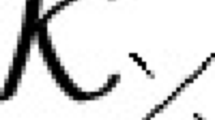Abstract
In this paper we study some consequences of the author’s classification of graph manifolds by their profinite fundamental groups. In particular we study commensurability, the behaviour of knots, and relation to mapping classes. We prove that the exteriors of graph knots are distinguished among all 3-manifold groups by their profinite fundamental groups. We also prove a strong conjugacy separability result for certain mapping classes of surfaces.
Similar content being viewed by others
References
M. Boileau and S. Friedl, Profinite completions and 3-manifold groups, survey article, https://doi.org/www.uni-regensburg.de/Fakultaeten/nat_Fak_I/friedl/papers/04Boileau-Friedl_ver3.pdf.
M. Boileau and S. Friedl, The profinite completion of 3-manifold groups, fiberedness and the Thurston norm, preprint, https://doi.org/abs/1505.07799.
M. R. Bridson, A. W. Reid and H. Wilton, Profinite rigidity and surface bundles over the circle, Bulletin of the London Mathematical Society 49 (2017), 831–841.
R. Budney, JSJ-decompositions of knot and link complements in the S 3, L’enseignement Mathématique 52 (2006), 319–359.
D. Eisenbud and W. D. Neumann, Three-dimensional Link Theory and Invariants of Plane Curve Singularities, Annals of Mathematics Studies, Vol. 110, Princeton University Press, Princeton, NJ, 1985.
C. McA. Gordon and J. Luecke, Knots are determined by their complements, Journal of the American Mathematical Society 2 (1989), 371–415.
F. Grunewald and P. Zalesskii, Genus for groups, Journal of Algebra 326 (2011), 130–168.
J. Hempel, Some 3-manifold groups with the same finite quotients, preprint, https://doi.org/abs/1409.3509.
A. Jaikin-Zapirain, Recognition of being fibred for compact 3-manifolds, preprint, https://doi.org/verso.mat.uam.es/~andrei.jaikin/preprints/fibering.pdf.
P. Orlik, Seifert Manifolds, Lecture Notes in Mathematics, Vol. 291, Springer, Berlin-New York, 2006.
L. Ribes and P. Zalesskii, Profinite Groups, Ergebnisse der Mathematik und ihrer Gren-zgebiete, Vol. 40, Springer, Berlin, 2000.
J.-P. Serre, Trees, Springer Monographs in Mathematics, Springer-Verlag, Berlin, 2003.
J. Stallings, On fibering certain 3-manifolds, in Topology of 3-manifolds and Related Topics, Proceedings of the University of Georgia Institute, Prentice Hall, Englewood Cliffs, NJ, 1962, pp. 95–100.
G. Wilkes, Profinite rigidity for Seifert fibre spaces, Geometriae Dedicata 188 (2017), 141–163.
G. Wilkes, Profinite rigidity of graph manifolds and JSJ decompositions of 3-manifolds, Journal of Algebra 502 (2018), 538–587.
H. Wilton and P. Zalesskii, Profinite properties of graph manifolds, Geometriae Dedicata 147 (2010), 29–45.
Author information
Authors and Affiliations
Corresponding author
Rights and permissions
About this article
Cite this article
Wilkes, G. Profinite rigidity of graph manifolds, II: knots and mapping classes. Isr. J. Math. 233, 351–378 (2019). https://doi.org/10.1007/s11856-019-1908-0
Received:
Revised:
Published:
Issue Date:
DOI: https://doi.org/10.1007/s11856-019-1908-0




